Easy Japchae (Korean Glass Noodle Stir-Fry)
Make japchae, Korean glass noodle stir-fry, the easy way with this simple recipe. Enjoy chewy sweet potato noodles, colorful veggies, and tender meat for an authentic Korean japchae taste.
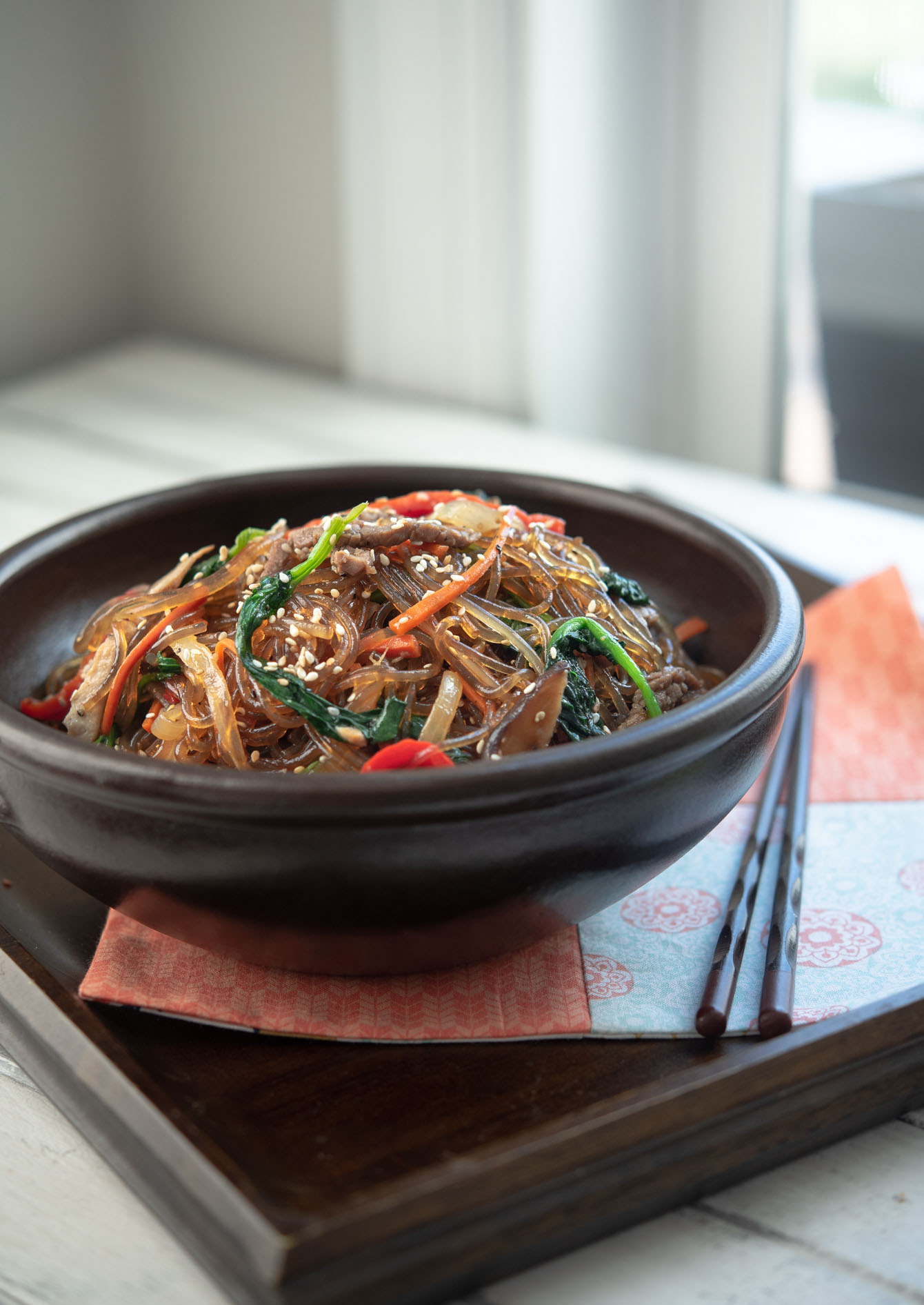
“Amazing taste! Easy to make. Hardest part was finding the right noodles. Can’t wait to make this recipe again.”
Maria
What is Japchae?
Japchae (잡채) is a tasty Korean noodle dish consist of chewy glass noodles mixed with colorful vegetables and juicy meat. The noodles called, dangmyeon (당면), are made from sweet potato starch, giving them their chewy texture.
Japchae is typically seasoned with soy sauce and sesame oil and served as a side dish or main course during special occasions such as New Year’s Day, Korean Thanksgiving, and family meals.
This traditional noodle dish in Korean cuisine usually takes time to make, but I’ve simplified the recipe. With a few shortcuts, you can enjoy homemade Japchae with less effort and still get that real authentic taste.
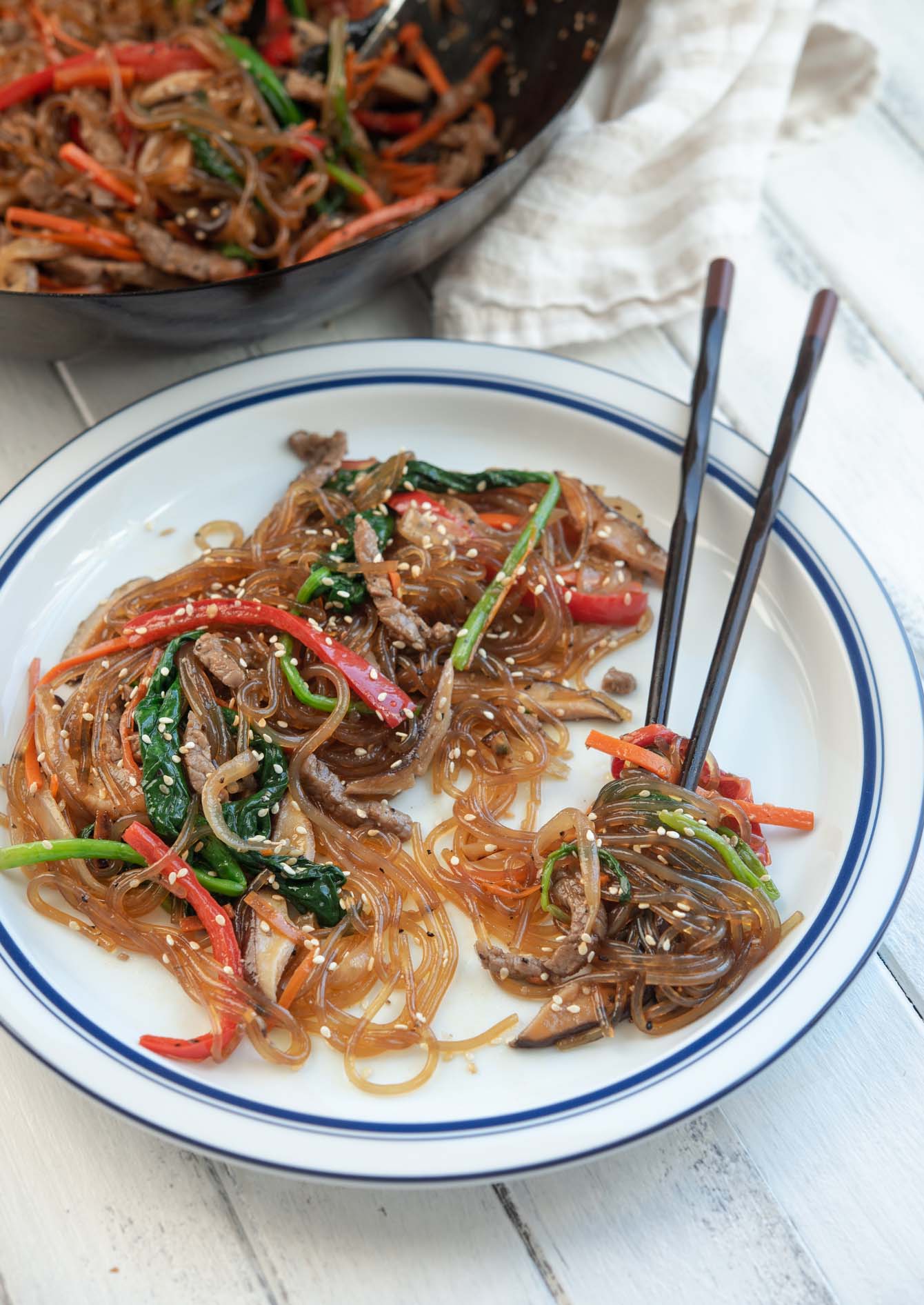
Japchae Ingredients
Here are what you will need for making this dish.
Noodles
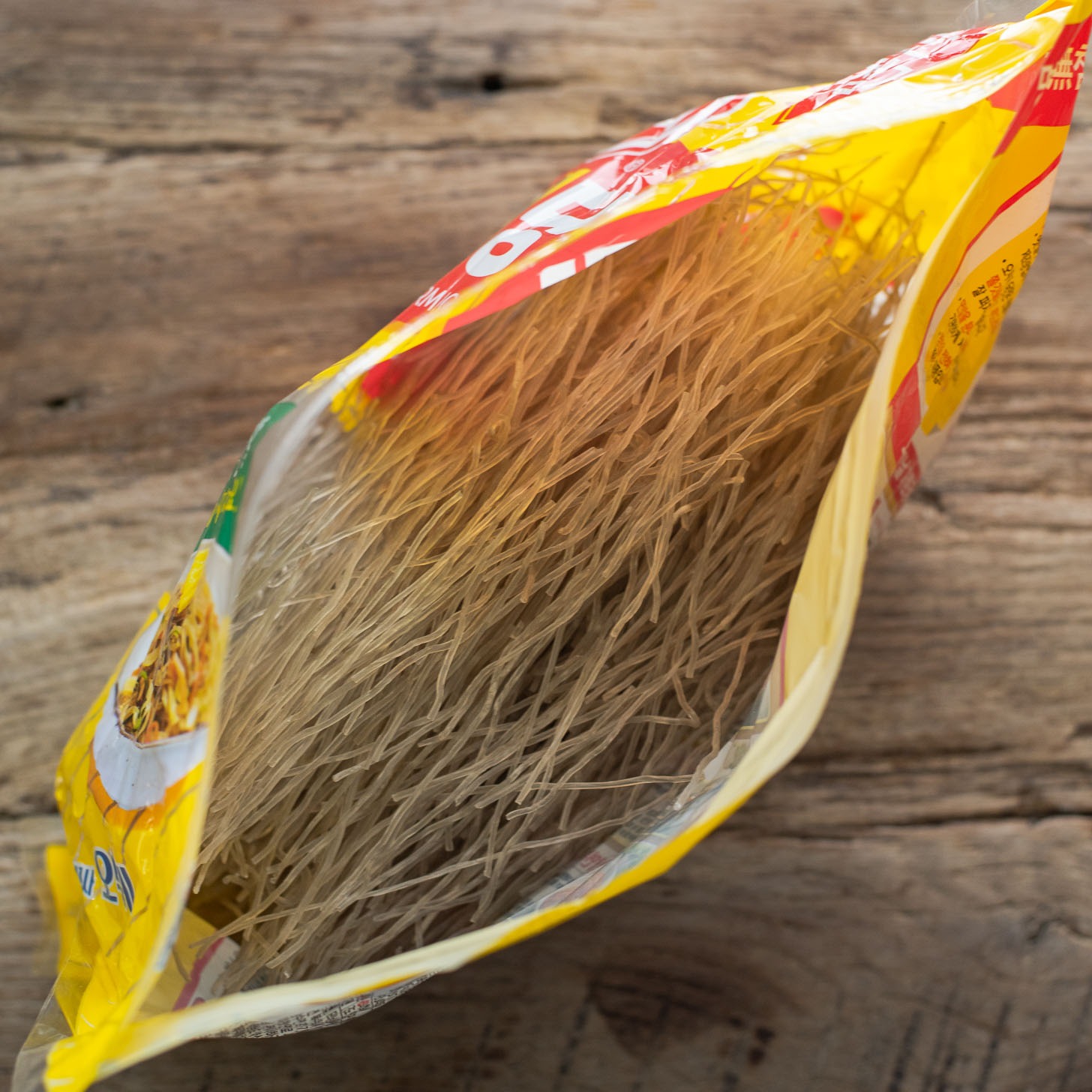
No Japchae is complete without dangmyeon (당면) in Korean kitchen. These Korean glass noodles, derived from sweet potato starch. These japchae noodles are clear and chewy and are quintessential in dishes like Andong jjimdak (Korean Braised Chicken) or Galbitang (beef short rib soup).
Where to buy japchae noodles (dangmyeon):
Dangmyeon can be easily obtained from Korean or Asian markets. Online stores is another option. They are often labeled as Korean potato vermicelli or Korean cellophane noodles. Make sure they are authentic Korean dangmyeon.
Japchae Sauce, Meat and Veggies
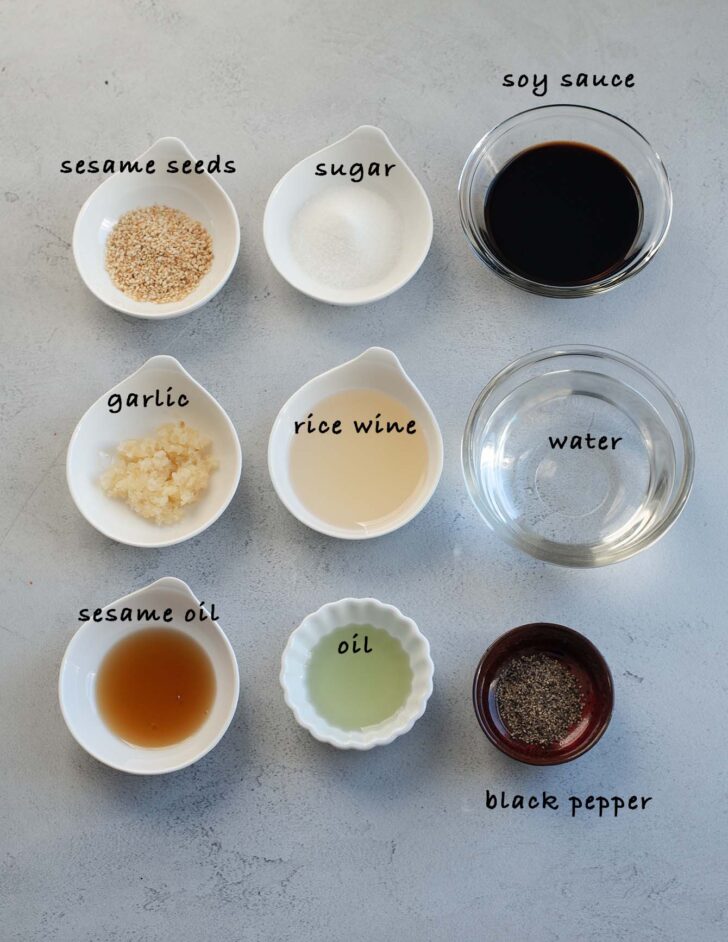
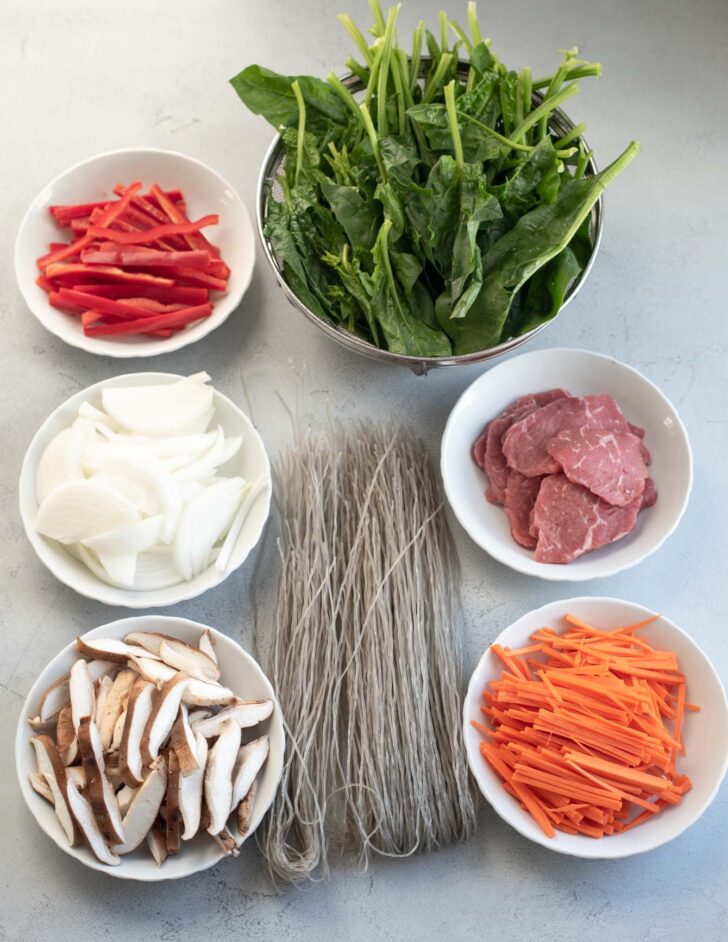
- Sauce: Usual things like soy sauce, garlic, sugar, oils. Sweet rice wine (mirin) is an optional choice.
- Meat: Beef or pork add a depth of flavor. Vegetarians can exclude this. Thin, tender cuts of beef such as sirloin or striploin are the most popular choices. You can quickly marinate the meat with basic bulgogi marinade ingredients to capture the full Korean flavor.
- To make vegetarian japchae: simply omit the beef. The dish remains delicious even without it.
- Veggies: Onion, carrot, pepper, spinach, and shiitake mushrooms are essential.
How to make Japchae (the Easy Way)
Prepare Noodles
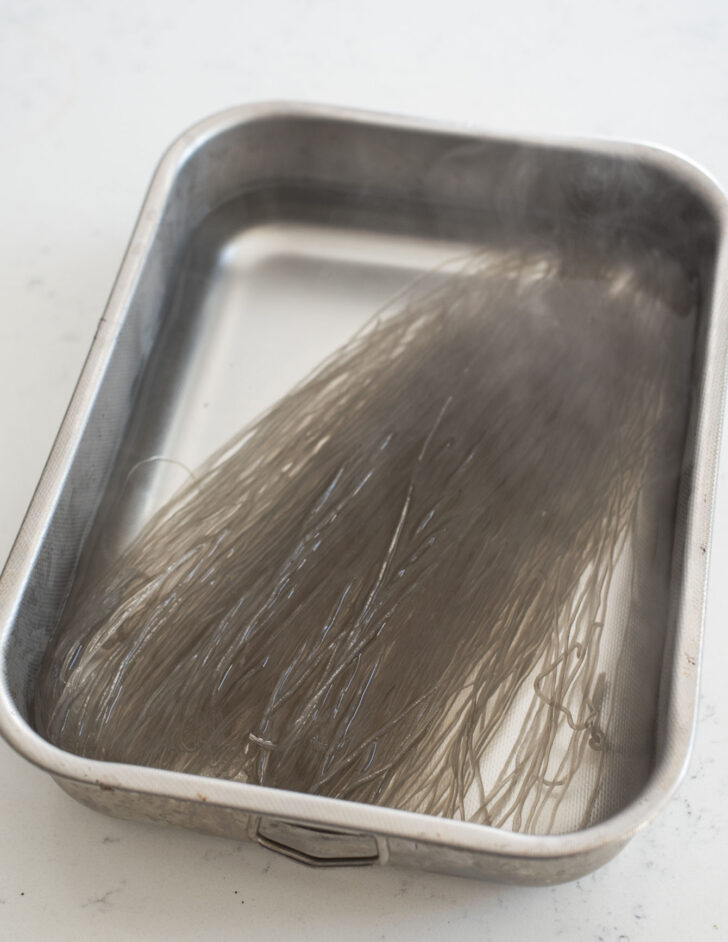
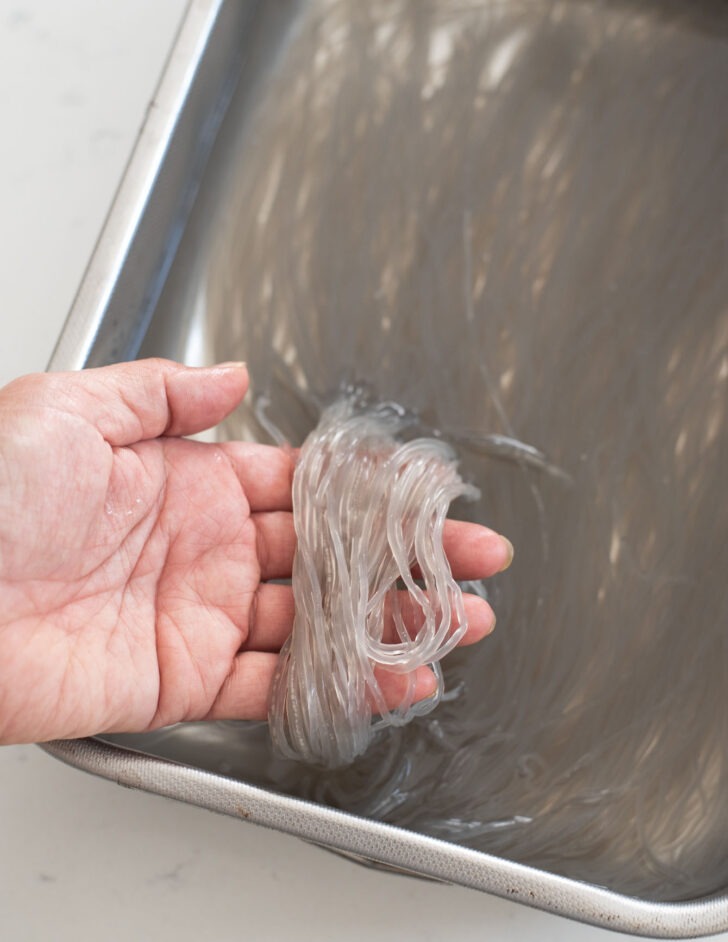
- Soak glass noodles (dangmyeon) in hot water for 15 minutes.
- After that, remove the water and keep the noodles to the side. This step makes them soft and ready to cook with sauce – faster cooking, less mess.
Meat Marinade and Sauce
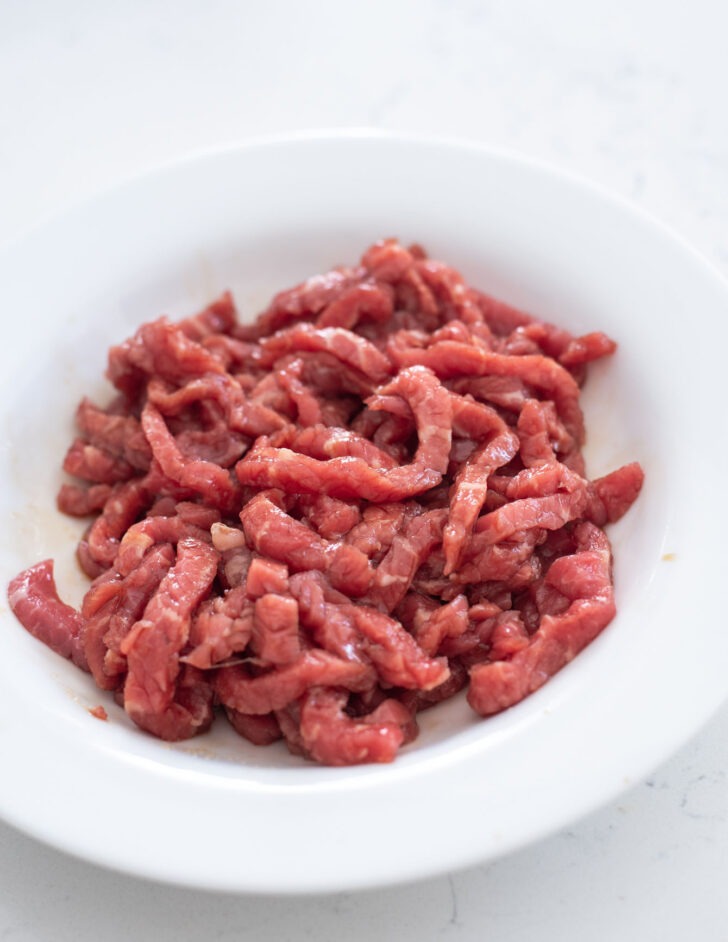
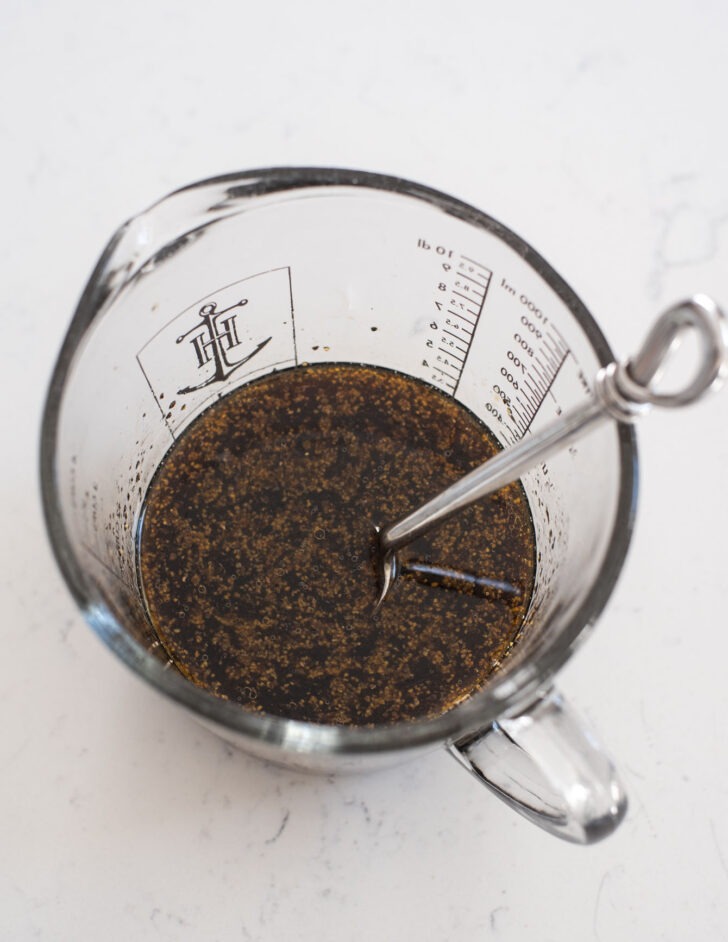
Meat Marinade
- Cut beef (or pork) into thin sticks, about 1/4-inch wide. Go against the way the fibers run.
- Mix them with soy sauce, sugar, and sweet rice wine. Then, keep them to the side to marinate.
Japchae Sauce
- Mix all the sauce seasoning ingredients in a bowl and keep to the side.
Stir-fry Vegetables
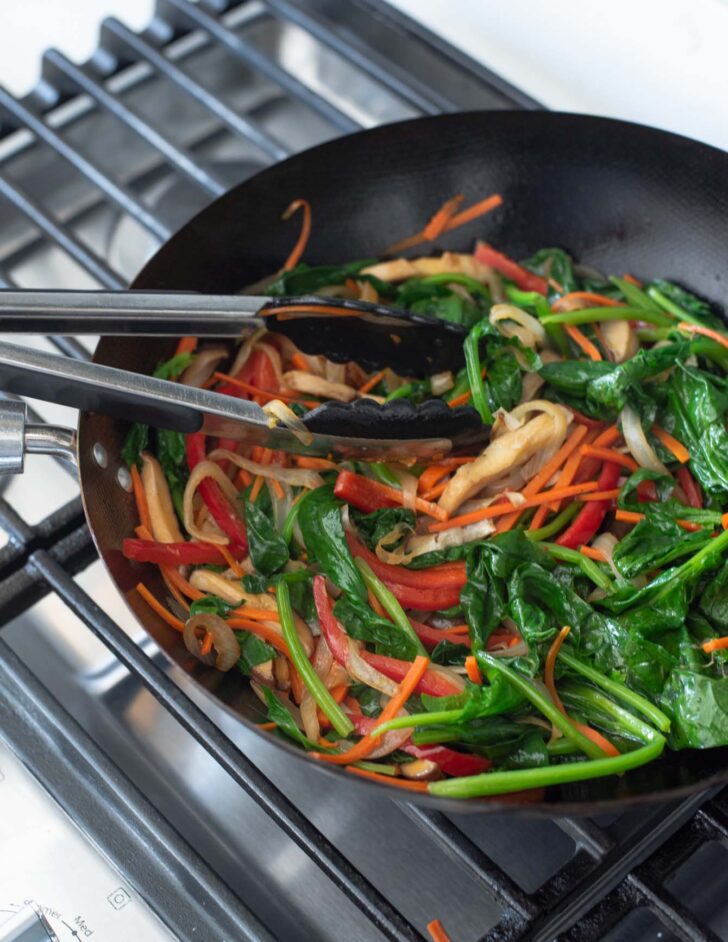
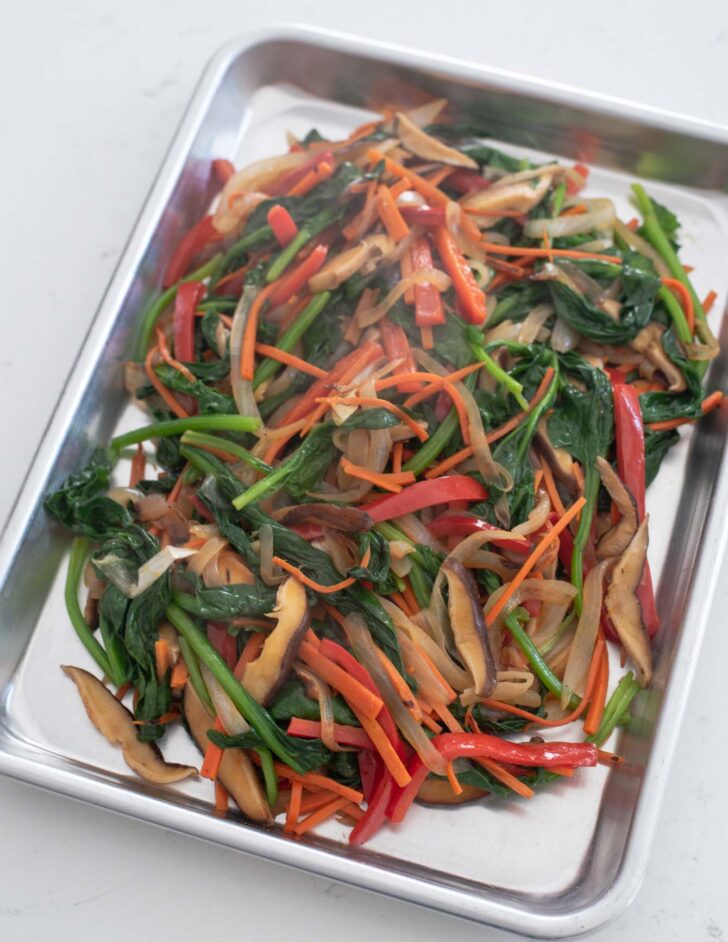
Stir-frying japchae vegetables
- Here’s an easy way to stir-fry veggies to shorten the cooking time: Start by cooking the veggies that take longer, like onions, carrots, and peppers. Then, toss in greens and mushrooms. This way, you cook faster and all the veggies taste great.
- Right at the end, add spinach and cook it until it’s soft. Then, take everything out of the pan and put it on a big plate to cool down.
Cooking the Meat
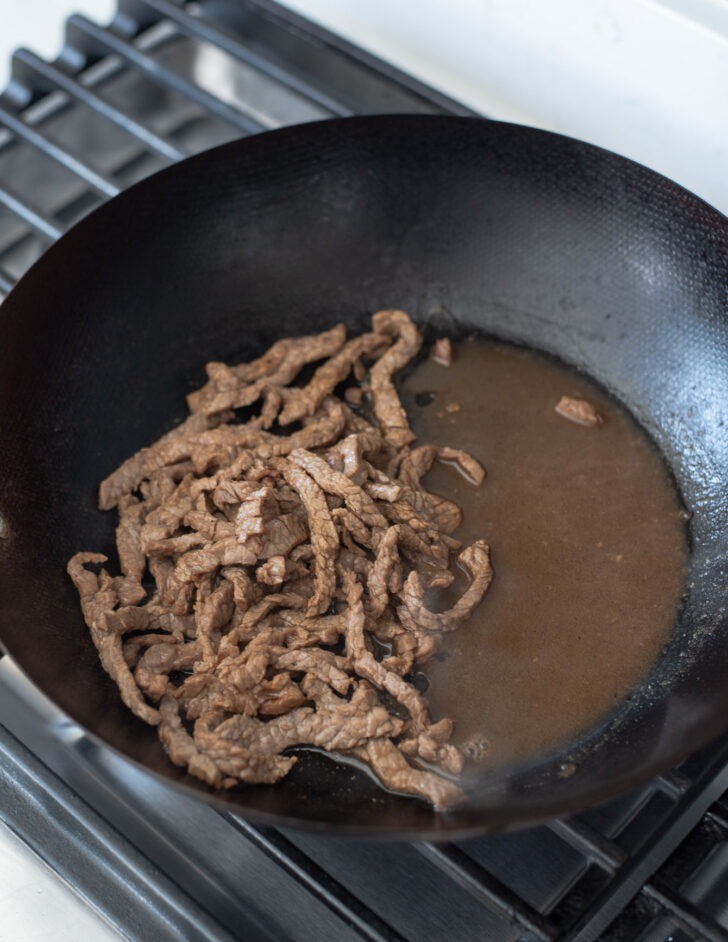
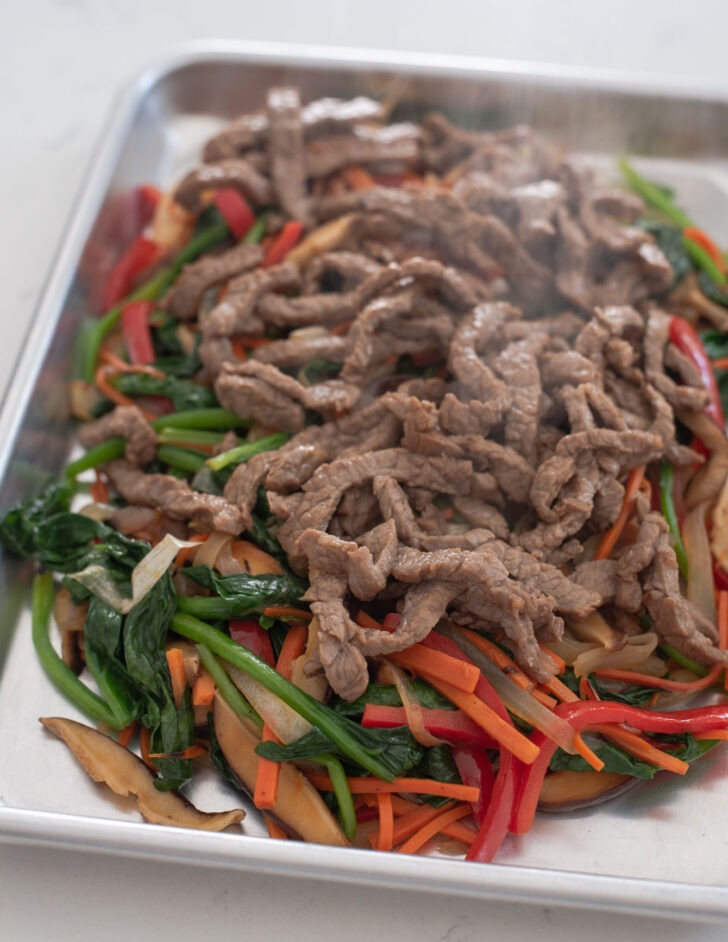
- Heat the pan up again on high heat and add the beef (or pork). Cook until it’s done. You’ll notice juice from the meat.
- Move the meat to the plate with the veggies, but leave the juice in the pan.
After cooking beef, keep the tasty juice in the pan. Mix it with the japchae sauce. It makes the noodles extra flavorful and yummy.
Assembling japchae
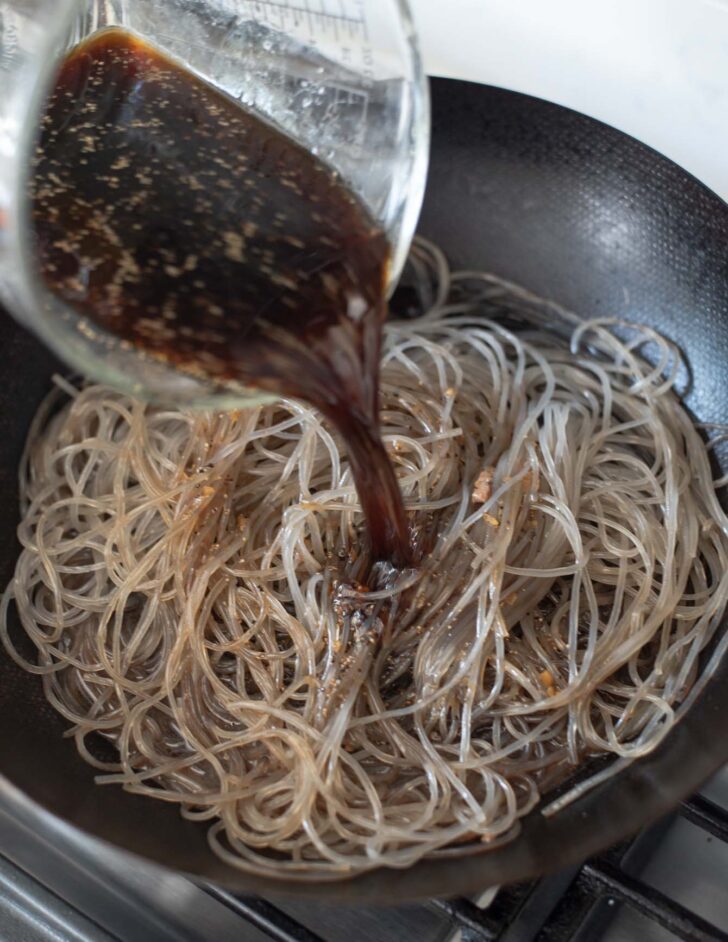
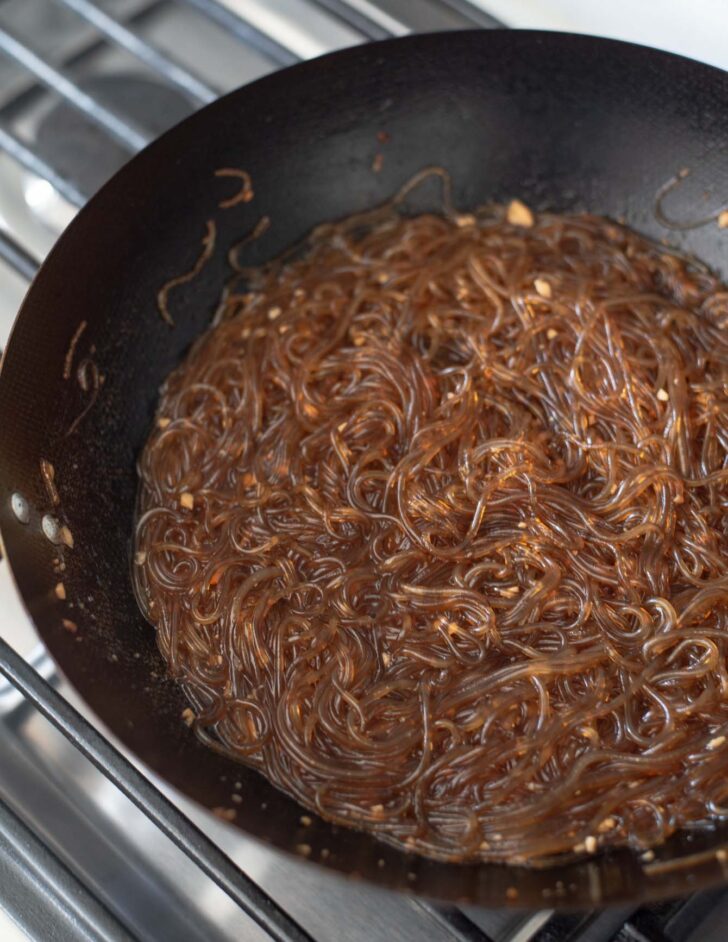
Seasoning the Noodles
- Put the drained noodles in the pan with the meat juices. Pour the seasoning sauce over them.
- Cook over medium heat until the noodles are very soft and most of the sauce is soaked up, which should take about 3-4 minutes.
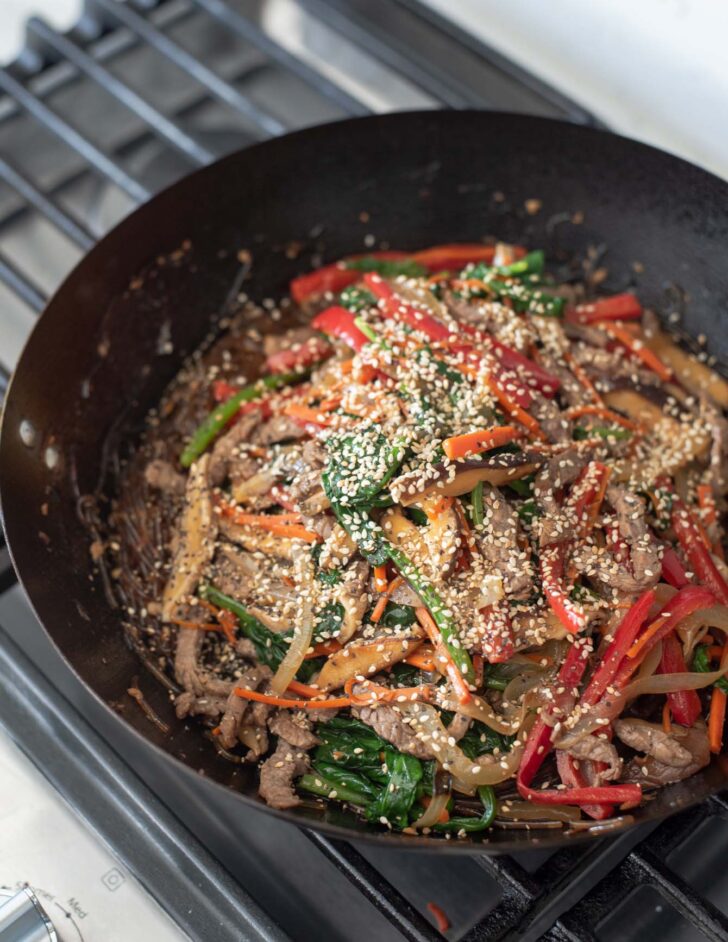
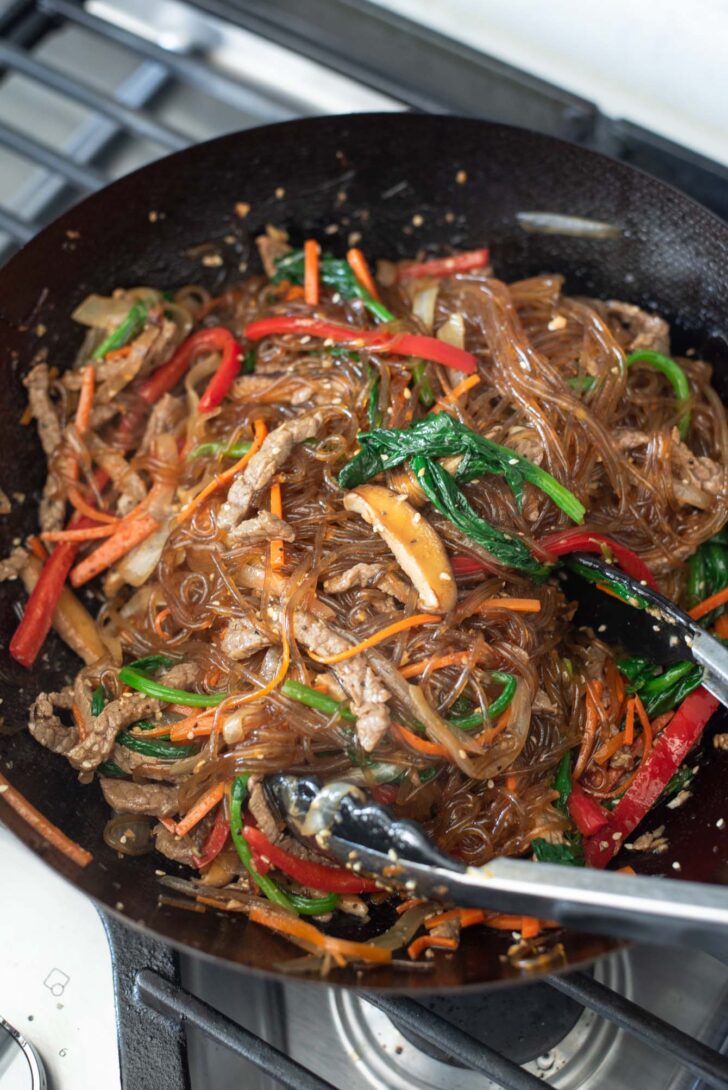
Toss all together
- Turn the heat down low. Put the veggies and meat back in the pan on top of the noodles.
- Add some sesame oil and seeds. Mix everything well. Add more sesame oil if you like. Check the taste and add more seasoning if you want.
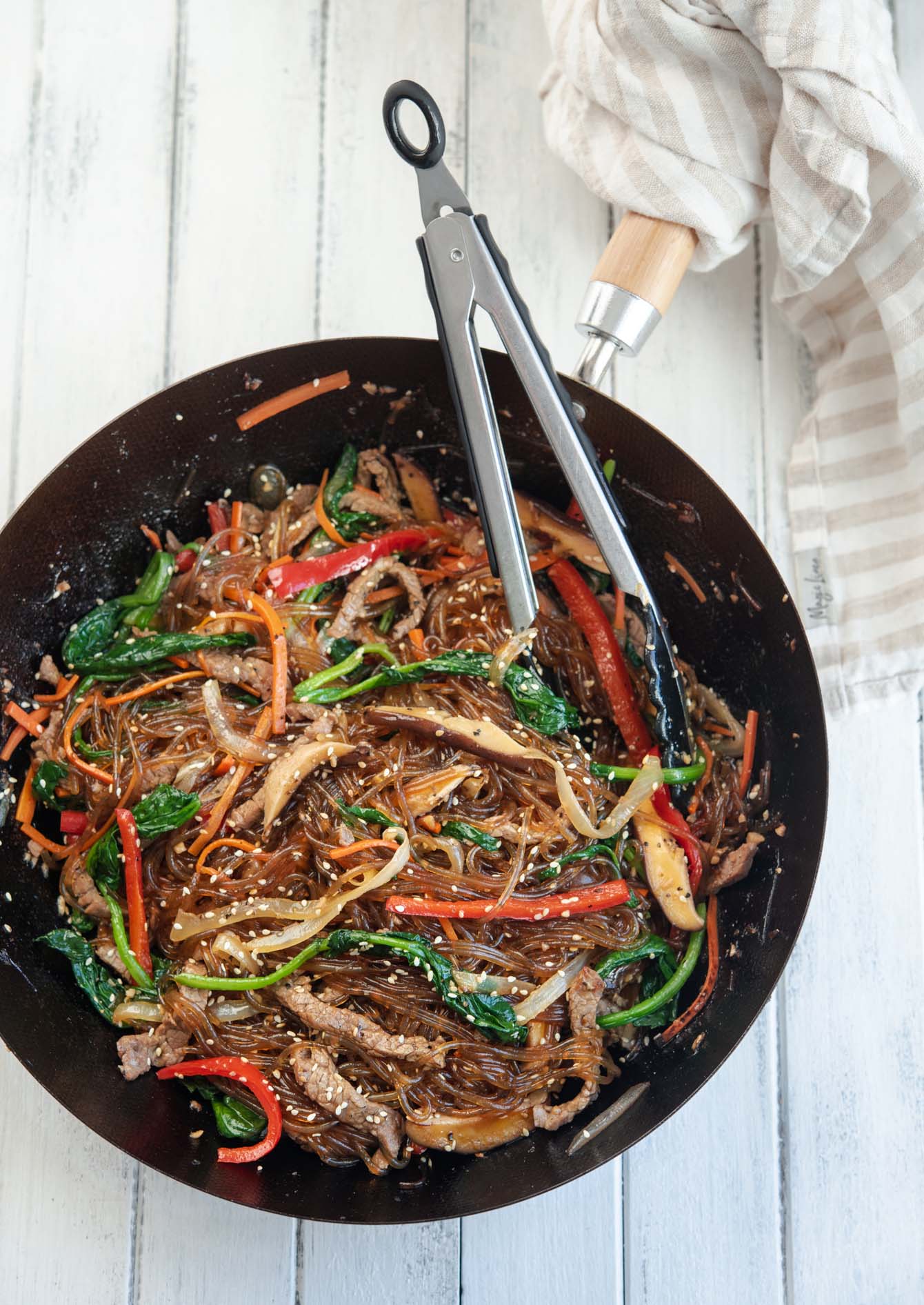
Storage and Reheating Tips
Store leftover japchae in the refrigerator. It will stay fresh for 3 to 4 days and reheats well in the microwave. For a fresher taste and texture, you can also stir-fry it with a little oil in a pan. The noodles will become soft and chewy again once reheated.
Love this recipe? Rate it and share your experience in the comments below! On Instagram? Tag me to showcase your creation. For more delicious recipes, subscribe to our newsletter!
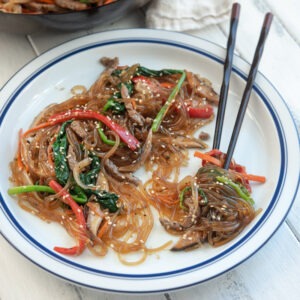
Easy Japchae (Korean Glass Noodles Stir-Fry)
Ingredients
- 8 oz (226 g) Korean glass noodles (dangmyeon)
- 6 oz (170 g) beef sirloin, or pork loin. See note below for the vegan/vegetarian option
- 2 tbsp oil
- 1 medium onion, thinly sliced
- 1 medium carrot, cut into thin matchsticks
- 1 small red bell pepper, thinly sliced
- a few pinches salt
- 5-6 shiitake mushrooms, sliced
- 1 bunch (about 6 oz, 170 g) spinach, cleaned
- 1 tbsp sesame oil
- 1 tbsp toasted sesame seeds
For meat marinade
- 1 tbsp soy sauce
- 1 tsp sugar
- 1 tbsp sweet rice wine (mirim)
For japchae sauce
- 4 tbsp soy sauce
- 1/2 cup (120 ml) water
- 2-3 tbsp sugar
- 2 tbsp sweet rice wine (mirim)
- 1 tbsp oil
- 2 cloves garlic, minced
- 1/2 tbsp black pepper
Instructions
For the glass noodles
- Soak the glass noodles in hot water for 15 minutes, then drain and set aside. Pre-soaking will soften the noodles and make them easier to cook.
For the meat seasoning
- Slice beef (or pork) into thin match sticks (about 1/4-inch thick) against grain and season with soy sauce, sugar, and sweet rice wine; set aside.
For the Japchae sauce
- In a mixing bowl, combine all the japchae sauce ingredients, and set aside.
To cook Japchae
- Heat 1 tablespoon oil in a large skillet or wok over medium high heat. Add onion, carrot, pepper, and a pinch of salt; stir-fry until soft but have a slight crunch to complement the soft noodles. Add sliced shiitake mushrooms and another pinch of salt. Continue to stir-fry until soft. Add more oil if needed.
- Add spinach at the end and stir-fry until spinach is wilted. Remove the skillet from the heat and transfer the vegetables to a large plate to cool.
- Reheat the pan over high heat with the remaining 1 tablespoon oil, add the beef (or pork) and stir-fry until fully cooked. You will see the juice coming out from the meat. Transfer the meat to the large plate with the reserved vegetables, reserving the juice in the pan.
- Add the drained glass noodles to the pan with the meat juices. Pour the japchae sauce over the noodles and toss to combine. Let the noodles cook over medium heat until they are soft and the sauce liquid is mostly absorbed into the noodles, about 3-4 minutes.
- Reduce the heat to low. Add the vegetables and meat back to the pan over the noodles. Add sesame oil and sesame seeds and toss all together to incorporate. Drizzle more sesame oil if you wish. Taste and season more according to your taste.


My husband and I loved this recipe! It had a little too much black pepper for my 3 year old and 1 year old so I’ll probably try it again with less.
So happy to hear that! Yes, reducing the amount of pepper is great for young children. Thank you so much for your comment!
You know its a keeper of a recipe when your teenagers practically empty the pan, before you dish yours up.
This recipe is the bomb, so good! I add about a 1/8 tsp of chili g arlic paste to it to give it a bit of a kick
I had this dish for the first time at Korean restaurant on a trip to California in April and it was amazing. When I got back home I looked for a recipe and found yours. It is just as amazing as what I got in the restaurant. My wife said it tasted just like it. I will be making this again and again.
Amazing taste! Easy to make. Hardest part was finding the right noodles. Can’t wait to make this recipe again.
Hi Maria
So happy to hear that you loved this recipe. I love making Japchae with this recipe and enjoy it every single time. Thanks.
Fantastic! Great spices and wonderful texture.
So great to hear that you loved this japchae. Thank you so much!
Great noodles. Wonderful taste and texture.
One of my all-time favourite Korean dishes! Looks delicious, Holly!
Delicious. I used the wrong noodles but it was still good. I also didn’t have spinach so used cabbage and that worked well.
That’s great! Cabbage will work great with japchae! Thanks for the comment. I appreciate it.
Hello! I can’t wait to make this recipe next week to celebrate the opening ceremony of the Olympics in South Korea! Can you tell me a substitute for the 1T of rice wine ? I prefer to not cook with alcohol! Thanks!
You can omit the wine. Enjoy the opening ceremony with Japchae
Should I increase the proportions of anything else if i am omitting the rice wine?
No need to increase anything.
Yum it turned out delicious thanks
One of my all time favorites and deceptively easy to make.
Hello. I used to eat Japchae a lot while I was an exchange student at HUFS in Seoul. Now You have given me an opportunity to remind this tasty dish. Will try more of your recipes. Thanks a lot. Greetings from Poland. Jacek
Hi Jacek
Glad to hear that you like Japchae. Hope you get to try my recipe and let me know if you have any questions. Cheers!
Your blog is a new discovery for me and I’m so excited I found it!! Being half Korean, many of these dishes are very familiar to me. Sadly, I never took the time to learn from my mother when she was cooking in the kitchen. Since she is no longer here, I am deeply grateful for these WONDERFUL tutorials you’ve presented. I find your clear descriptions and colorful photos very helpful. A few days ago, I made the cucumber kimchi and tonight, I made the Japchae. What a treat…to take me back to my childhood with all the familiar smells of red pepper, garlic, sesame seeds and soy sauce…ah, mom would be proud <3 Both dishes were just as delicious as I remember. Thank YOU!!!
Thanks for your sweet comment. It is my utmost pleasure to hear that my recipes are helping other people to remember their childhood memories. Food has a great power to do that. Hope you continuously enjoy your Korean cooking.
Hi Holly,
I have tried all your 3 recipes for Japchae and all 3 are lovely. We end up taking 2nd and 3rd helpings. Thank you.
That is so great! You made my day so happy!
Wow! I ran across your website by accident looking for a “chocolate sour cream cake” recipe, what a great mistake “what is this kim chee thing?” I thought to myself. Japchae recipe, I love to eat it but I can make it too? With your great recipe, photos and instructions I made my first batch of the most amazing Japchae, even better than the ones I have at our little Korean restaurant in Hawaii. Thank you thank you. I have read many of your recipes and cannot wait to try them. They all look so good. My only thought is “what recipes can I share with you?” I just made my mother’s famous “won ton” filling and thought how I wish I could share these with you. Maybe you already have a recipe for good won tons? Let me know if you don’t.
thank you thank you again.
Hi Deanna
Thank you so much for your lovely comment. You are so kind to offer me a recipe in return and I appreciate your thoughtfulness. I LOVE wonton and would love to get your mother’s recipe. Please, share with me. Also I am so happy that you liked my Japchae recipe. Homemade is always better, isn’t it?
Hi Holly,
I was anxious making this because it’s my first time trying Asian food with its different ingredients and way of cooking.. But It turned out very well! Despite few minor changes, I liked this dish so much, and would make it again for sure 🙂
Thanks for the recipe!
Hi Holly,
I was anxious making this because it’s my first time trying Asian food with its different ingredients and way of cooking.. But It turned out very well! Despite few minor changes, I liked this dish so much, and would make it again for sure 🙂
My favorite! Liked the tip about placing the beef on paper towels to drain. Thank you!
i have fallen in love with your recipes!! :*
Thank you for this! I am going to follow your instructions and try to make this myself. Well done!
Nicely done. Thanks for the photos. It always a big plus to know what brand to buy when cooking. What brand do you like to use for rice wine? Also, what is the white and yellow strips topping on the noodles? Thank you!
You can use any brand for rice wine. The yellow and white strips on the dish are fried, then thinly sliced egg yolk and egg white.
Hi, just wanted to say, I enjoyed this blog post. It was inspiring.
Keep on posting!
Hello there! Would you mind if I share your blog with my myspace group?
There’s a lot of folks that I think would really enjoy your content. Please let me know. Many thanks
That would be great! Thanks.
I really love this noodle – Japchae (now i know exactly its Korean name). Will try it tomorrow
Thanks a lot
Hello, i think that i saw you visited my web site so i came to “return
the favor”.I am trying to find things to improve my web site!
I suppose its ok to use some of your ideas!!
I made this few nights ago and it was really delicious. I love the crunch of the carrot. And I’ve never had potato noodle before, but it’s so satisfyingly chewy. But, the most important lesson I took from this post is how to get rid of dirt from spinach!! For the life of me, I’ve never thought to soak spinach before so that the dirt can be washed off and settle at the bottom. Previously I would only rinse under running water and as such there are always stubborn grains of dirt on the spinach.
Hello! Thanks for the recipe! My family absolutely loved this dish. They gobbled it up like they haven’t eaten in days! 🙂
I just started a blog and I noticed that your fabulous blog started with japchae too! Love you site!
I got to do this one today. My husband, who is constantly comparing my cooking with his Korean mother’s cooking, loves it!! He admitted, I cooked this one better than my mother in law…. Thank you so much!
Thank you Janeth. I am so happy to hear that.
Hello!
Just so you know…the font you used for the first four pictures doesn't work so well for some computers. I'm on XP and I'm using chrome and it comes up as gunk. If I use Firefox things look great but I don't think Chrome likes the font.
I just copied and pasted it into an email and it looks just fine!
I am Korean student in Japan. I want to try this someday.
I made this tonight and it was delicious! I've tried for years to find a japchae recipe that was "right" and this is it. Thank you 🙂
You can double the recipe. However, the amount of seasoning on each ingredients doesn't have to be exact to the T. Adjust (+ or -) the seasonings depends on your taste. Japchae is a dish that you can season along as you make. Have a fun making!
Hello hello! I absoulutely love your blog and I'm looking forward to trying all these recipes! Just one question, for this recipe, can you double it by just doubling all the ingredient amounts? Or should it be in another ratio? Thanks so much for all the effort that you put into making this blog fantastic!!
Everything is okay. Although the symbols under the first three pictures are undicipherable, when I copy and paste the garbled paragraphs using wordperfect 11 the words (recipe) comes up in English! I have no idea why this occurs but since I can read it it's okay. Thank you. ^^
Hello! Actually, the email I wrote you was changed from the original. I copied and pasted the symbols under the first, second and third picture, but for some reason they were deleted in my post. 'Okay, I am nervous right now. This is my' isn't what I was saying..seems like it was part of yours…. I don't kwow.. –; The first English words I can see on my computer are "slice beef (cross grain) into 1/4" inch strips." This is under the fourth picture. For some reason the first few paragraphs are all strange symbols. I'll check on another computer someother time.. Thanks.*^.^*
@039abfd1fc430a33159afb6b9a81148d
Hi! how can I help you? Because I can see my words clearly under the first picture. All it says is that this was my very first post and how nervous I was.
I cannot read the begining ..right under the first picture..starts like..Okay, I am nervous right now. This is my please help!!! Thank you ~! *^.^*
Okay, I am nervous right now. This is my very first blog posting and I don't think anybody will find this or read this posting but why am I still nervous? Would you allow me to go and grab plateful of Japchae and I will continue to write this down as I am eating….?
Japchae (잡채) is perhaps the most famous Korean noodle dish. It is a must for any banquet or feast table. You can eat this dish alone or with some rice. This can be a great vegetarian dish as well if yo omit the beef. The key to making flavorful Japchae is seasoning each ingredient separately. Let me show you how you can make this beautiful dish to impress your significant others. Are you ready?
Japchae is new to my ears. But I like spicy foods. Maybe that's why I fancy Korean Cuisine. A lot of their foods recipe have one or two spicy ingredients in it like gochujang and gochugaru. Thanks for sharing this recipe. I'll definitely make one for our Korean Night. Korean Noodles and Korean TV – a healthy dose of Korean Idols like GDragon and TOP! 🙂
T is for tablespoon, and t is teaspoon.
does 'T' stand for teaspoon or tablespoon?
wow thanks for the very very detailed instructions and photos!
Very helpful cooking hints – i love Japchae! However, I'm lazy, and I cook the ingredients (except noodles) one after the other in a large frypan: onions, garlic, then carrots, followed by mushrooms. Then spinach, and lastly the noodles (which have been prepared per your recipe). I season each batch of ingredients. Then I add pinenuts just before serving (as my dish is vegetarian).
@Laura
Great! I am so happy to hear that you like the recipes. You Japchae looks fabulous! I want some now! 🙂
i fell upon your blog from foodgawker (originally looking for choco chip cookies) and TOTALLY fell in love with it. not only did i make the cookies today (btw, they're the BEST choco chip cookies i've ever tasted), i made 잡채 today for dinner =)it's my first time making it, your recipe and instructions were so easy to follow. thanks so much!
nice first post! looking forward to following your blog 🙂
masa
this is a famous Asian dish. hmm, looks very delicious. I love vegetables and the colors of it when mixed on noodles. planning to cook a good asian food soon.
I am glad that I taught you something. You can be creative and add other veges in the recipe. Some people add red or green peppers in the dish. I'm not a big fan of bell peppers in Japchae. To me the smoky flavor of peppers overpower the dish, but it is personal preference. I think zucchini or squash can be good addition as long as you use toward the skin part. The seeded area can be mushy and watery. Hope this helps.
I just made Japchae for a big dinner party on Sunday – served 21 people and still had tons of leftovers! I followed this recipe fairly closely, even before I found this blog, but I think you WERE the one who taught me how to make it. One difference was that I added some zucchini and summer squash, cut in matchsticks. Good stuff!